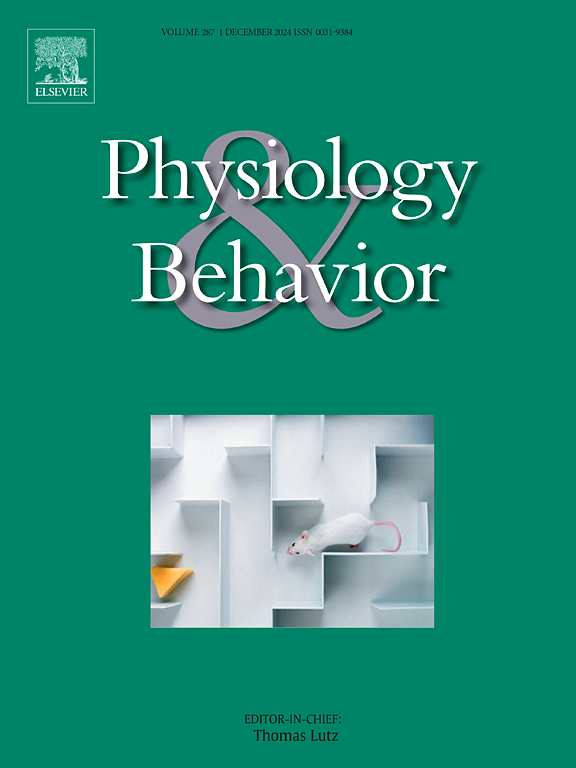How the presence of a dog and types of interaction affect physiological responses to experimental heat pain induction in healthy humans - a randomized controlled study
IF 2.5
3区 医学
Q2 BEHAVIORAL SCIENCES
引用次数: 0
Abstract
It has become increasingly popular to include dogs as a complement to regular therapy, with the expectation that they offer, among other benefits, pain-relieving effects. Meanwhile, studies covering the topic of painful situations within the field of animal-assisted interventions (AAI) present conflicting results and rarely consider the type and duration of interaction with the dog. Thus, the impact of human-dog interactions on physiological measurements during painful situations is largely unknown. Basic research is needed on the effects of interacting with a dog, using commonly applied immediate physiological measurements in healthy humans during experimental pain induction to fill this gap in the literature.
The present study investigated how AAI influences physiological measurements when healthy humans are subjected to experimental heat pain induction. Simultaneously, the study explored how the duration of different types of interaction with a human companion or a dog as well as dog behavior during experimental heat pain induction affected physiological measurements.
Fifty-eight healthy participants (14 men, 44 women, age: 18-66 years) were randomly assigned to one of two intervention groups: 1) a dog and a human companion or 2) a human companion only. Both intervention groups underwent two test conditions in a balanced order: an active test condition with their allocated intervention and a control test condition without their allocated intervention. The participants were exposed to a 5-minute heat pain induction trial in both test conditions with a 20-minute break between trials. Heart rate (HR), heart rate variability (HRV) and skin conductance (SC), analyzed as tonic level (SCL) and peak counts (SCR), were continuously recorded. Blood pressure (BP) and salivary cortisol (s-cortisol) were collected as pre- and post-measurements for each test condition. Behavioral interactions between the participant, dog and human companion as well as behavior of the dog were recorded and the influence of the behavioral interactions on each physiological measure was analyzed. Linear Mixed Models were applied.
HR was higher for the intervention group with a dog and a human companion compared to a human companion only (p=0.013). Additionally, within-subject comparison showed an increased HR during the active condition compared to the control condition in both intervention groups (dog and human companion: p<0.001 and human companion only: p=0.025). None of the other physiological measurements were influenced by the mere presence of a dog in either the between- nor within-subject comparisons. Within the human companion only group, SCL and SCR were higher during the active condition compared to the control (both p<0.001). The duration of the behavioral interaction between the participant and human companion variously influenced HRV, SBP, s-cortisol and SCL during the active condition in both intervention groups. Further, the duration of the behavioral interactions with the dog and dog behavior variously influenced HR, HRV, s-cortisol and SCL during the active condition in the human companion and the dog intervention group.
In conclusion, this study shows that the presence of a dog in addition to a human companion during experimental heat pain induction results in an increased HR compared to the presence of a human companion only. Thus, despite previously reported pain-relieving effects of the presence of a dog, this study suggests that dog presence may also induce a certain level of arousal and further studies are needed to explore the causal mechanisms. Interactions with a dog or a human companion influenced several physiological measurements and it is therefore important to quantify the type and duration of human-animal interaction in AAI-studies.
狗的存在和相互作用的类型如何影响健康人对实验性热痛诱导的生理反应-一项随机对照研究
把狗狗作为常规治疗的补充已经变得越来越流行,人们期望它们能提供缓解疼痛的效果。同时,涉及动物辅助干预(AAI)领域的疼痛情境主题的研究得出了相互矛盾的结果,很少考虑与狗互动的类型和持续时间。因此,在痛苦的情况下,人类与狗的互动对生理测量的影响在很大程度上是未知的。需要对与狗互动的影响进行基础研究,在实验性疼痛诱导过程中使用健康人类常用的即时生理测量来填补这一文献空白。本研究探讨了当健康人体遭受实验性热痛诱导时,AAI如何影响生理测量。同时,该研究探讨了在实验热痛诱导过程中,与人类伴侣或狗的不同类型互动的持续时间以及狗的行为如何影响生理测量。58名健康参与者(14名男性,44名女性,年龄:18-66岁)被随机分配到两个干预组中的一个:1)狗和人类伴侣或2)只有人类伴侣。两个干预组都以平衡的顺序进行了两种测试条件:一种是有分配干预措施的积极测试条件,另一种是没有分配干预措施的对照测试条件。参与者在两种测试条件下都进行了5分钟的热痛诱导试验,两次试验之间休息20分钟。连续记录心率(HR)、心率变异性(HRV)和皮肤电导(SC)(以强直水平(SCL)和峰值计数(SCR)分析)。收集血压(BP)和唾液皮质醇(s-皮质醇)作为每个测试条件的前后测量值。记录参与者、狗和人类同伴之间的行为互动以及狗的行为,并分析行为互动对各项生理指标的影响。采用线性混合模型。有狗和人类伴侣的干预组的HR高于只有人类伴侣的干预组(p=0.013)。此外,受试者内部比较显示,与对照组相比,两个干预组(狗和人类伴侣:p= 0.001,仅人类伴侣:p=0.025)活动状态下的HR增加。在被试之间和被试内部的比较中,其他的生理测量结果都没有受到狗的影响。在只有人类伴侣的组中,与对照组相比,活跃状态下的SCL和SCR更高(p<0.001)。在两个干预组中,参与者与同伴之间行为互动的持续时间不同程度地影响了活跃状态下的HRV、收缩压、s-皮质醇和SCL。此外,与狗的行为互动的持续时间和狗的行为不同程度地影响了人类伴侣和狗干预组在活动状态下的HR、HRV、s-皮质醇和SCL。总之,这项研究表明,在实验热痛诱导过程中,除了人类伴侣之外还有狗的存在,与只有人类伴侣的存在相比,会导致HR增加。因此,尽管之前有报道称狗的存在有缓解疼痛的作用,但本研究表明,狗的存在也可能诱发一定程度的觉醒,需要进一步的研究来探索其因果机制。与狗或人类伴侣的相互作用会影响一些生理测量,因此在人工智能研究中,量化人与动物相互作用的类型和持续时间很重要。
本文章由计算机程序翻译,如有差异,请以英文原文为准。
求助全文
约1分钟内获得全文
求助全文
来源期刊

Physiology & Behavior
医学-行为科学
CiteScore
5.70
自引率
3.40%
发文量
274
审稿时长
47 days
期刊介绍:
Physiology & Behavior is aimed at the causal physiological mechanisms of behavior and its modulation by environmental factors. The journal invites original reports in the broad area of behavioral and cognitive neuroscience, in which at least one variable is physiological and the primary emphasis and theoretical context are behavioral. The range of subjects includes behavioral neuroendocrinology, psychoneuroimmunology, learning and memory, ingestion, social behavior, and studies related to the mechanisms of psychopathology. Contemporary reviews and theoretical articles are welcomed and the Editors invite such proposals from interested authors.
 求助内容:
求助内容: 应助结果提醒方式:
应助结果提醒方式:


